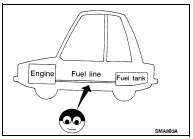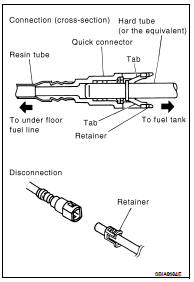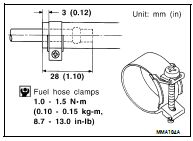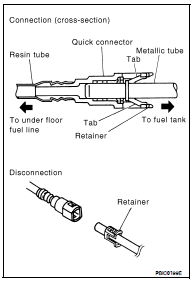Nissan Altima (L32) 2007-2012 Service Manual: On-vehicle maintenance
FUEL SYSTEM
Inspection
Inspect fuel lines, fuel filler cap and fuel tank for improper attachment, leaks, cracks, damage, loose connections, chafing or deterioration.
If necessary, repair or replace damaged parts.

Quick Connector
CAUTION: • After connecting fuel tube quick connectors, make sure quick connectors are secure.
Ensure that connector and resin tube do not contact any adjacent parts.

General Precaution
WARNING: When replacing fuel line parts, be sure to observe the following.
• Put a “CAUTION: FLAMMABLE” sign in the work area.
• Be sure to work in a well ventilated area and have a CO2 fire extinguisher.
• Do not smoke while working on the fuel system. Keep open flames and sparks away from the work area.
CAUTION: • Before removing fuel line parts, carry out the following procedures: - Put drained fuel in an explosion-proof container and put the lid on securely. Keep the container in safe area.
- Release fuel pressure from the fuel lines. Refer to EC-550, "Inspection" (QR25DE for California), EC- 1038, "Inspection"(QR25DE except for California), EC-1579, "Inspection" (VQ35DE).
- Disconnect the battery ground cable.
• Always replace O-rings and clamps with new ones.
• Do not kink or twist tubes when they are being installed.
• Do not tighten hose clamps excessively to avoid damaging hoses.
Tighten high-pressure rubber hose clamp so that clamp end is 3 mm (0.12 in) from hose end.
Tightening torque specifications are the same for all rubber hose clamps.
Ensure that screw does not contact adjacent parts.

• After connecting the fuel tube quick connectors, make sure the quick connectors are secure.
Check that the connector and resin tube do not contact any adjacent parts.
- a) Apply fuel pressure to the fuel system by turning the ignition switch to ON (without starting the engine). Then check for fuel leaks at the fuel tube connections.
- b) Start the engine and rev the engine, then check for fuel leaks at the fuel tube connections.
• After installing the tubes, run the engine and check for fuel leaks at the connections.
• Use only a Genuine NISSAN fuel filler cap as a replacement. If an incorrect fuel filler cap is used, the MIL may come on.
• For servicing “Evaporative Emission System” parts, refer toEC-34, "System Description" (QR25DE for California), EC- 570, "System Description" (QR25DE except for California).
• For servicing “On Board Refueling Vapor Recovery (ORVR)” parts, refer to EC-476, "Description" (QR25DE for California), EC-969, "Description" (QR25DE except for California) EC- 1497, "Description" (VQ35DE).


 Preparation
Preparation On-vehicle repair
On-vehicle repair